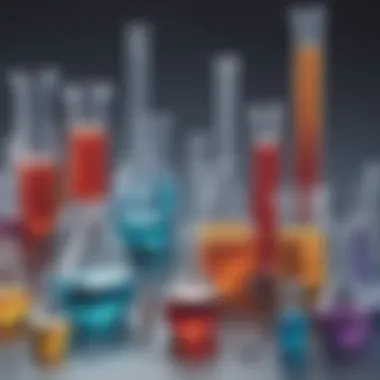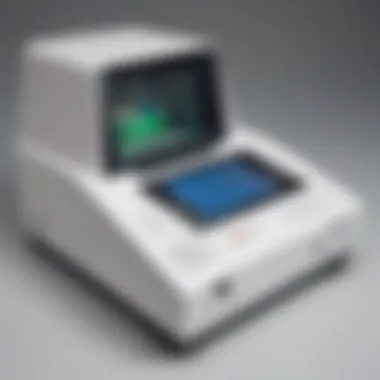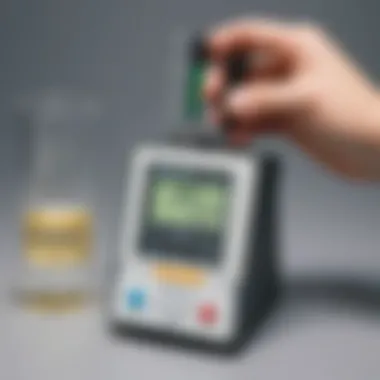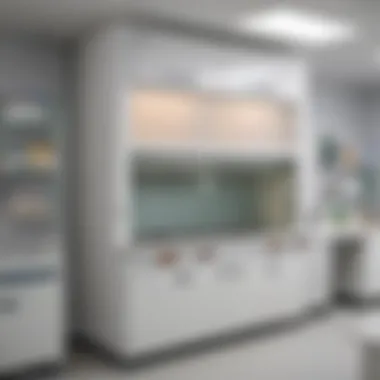Unveiling an Array of Chemical Laboratory Equipment Names for Enthusiasts


Science Fun Facts
Chemical laboratories are like playgrounds for scientists, filled with intriguing tools and equipment that enable groundbreaking discoveries. Did you know that one essential piece of lab equipment is the test tube? These cylindrical vessels made of glass are used to mix, heat, and store small quantities of chemicals in experiments. They come in various sizes, from miniature to large, depending on the volume of the substances being handled.
Discover the Wonders of Science
In the realm of chemical lab equipment, there are various scientific concepts waiting to be explored. For example, understanding the function of a Bunsen burner can shed light on the principles of combustion and heat transfer. Through educational videos and animations illustrating the use of this iconic lab tool, budding scientists can grasp how controlled flames play a crucial role in conducting experiments. Real-life applications of the Bunsen burner extend beyond the lab into fields like cooking and metalworking, showcasing its significance in everyday life.
Science Quiz Time
Are you ready to test your knowledge of chemical lab equipment names? Here's a brain teaser for you: Which lab apparatus is commonly used for precise measurements of liquid volumes and is shaped like a narrow cylinder with a spout? If you guessed a graduated cylinder, you're right! Interactive quizzes like these help reinforce learning by engaging participants in fun and stimulating activities. Multiple choice questions about lab equipment can enhance memory retention and critical thinking skills, making the learning process exciting and rewarding.
Science Experiment Showcase
Embark on a journey of scientific exploration by conducting fun and engaging experiments using diverse lab equipment. One intriguing experiment involves observing chemical reactions using a microscope. Step-by-step instructions guide you through setting up the experiment, from preparing samples to adjusting the microscope settings for optimal viewing. A materials list ensures you have all the necessary equipment, while safety tips and precautions underscore the importance of responsible lab practices. Get ready to witness the wonders of science unfold right before your eyes!
Introduction
In the realm of scientific exploration and experimentation, the intricacies of chemical lab equipment play a pivotal role in shaping our understanding of the world around us. This article serves as a guiding beacon into the vast array of tools and instruments that grace the laboratories where groundbreaking discoveries are born. From the humble beaker to the sophisticated analytical devices, each piece of equipment holds a unique significance in unraveling the mysteries of chemistry.
As we embark on this journey of exploration, we shall unfurl the curtain veiling the essential glassware, the indispensable heating and cooling apparatus, the precise measuring instruments, and the crucial safety equipment that form the backbone of any laboratory setting. Whether you are a novice scientist taking your first steps into the world of chemistry or a seasoned veteran honing your craft, a thorough understanding of these tools is fundamental to your success. So, fasten your seat belts and get ready to delve deep into the fascinating realm of chemical lab equipment names.
Glassware


Glassware in the laboratory is a fundamental component that facilitates various chemical processes and experiments. It encompasses a wide array of tools designed to contain, mix, and heat substances safely and effectively. Essential glassware includes beakers, flasks, test tubes, and pipettes, each serving distinct purposes. Beakers are cylindrical containers with a spout used for stirring, mixing, and heating liquids. Flasks, characterized by a rounded bottom, are utilized for storing chemicals and conducting reactions. Test tubes are elongated, narrow tubes employed to hold small samples or carry out experiments on a small scale. Pipettes, on the other hand, are precise measuring devices for transferring liquids accurately. The choice of glassware is crucial as it ensures proper handling of chemicals and allows for accurate measurements and observations during laboratory work.
Beakers
Beakers are essential glassware items in laboratories, playing a significant role in various experimental procedures. They are characterized by a cylindrical shape with a flat bottom and a spout for easy pouring. Beakers come in different sizes, allowing for the handling of varying volumes of liquids. Their transparency enables clear visibility of the contents, aiding in observation and measurement. Beakers are commonly used for stirring, heating, and mixing substances, making them versatile tools in chemical experimentation. Proper handling and cleaning of beakers are essential to avoid contamination and ensure accurate results in experiments.
Flasks
Flasks are indispensable in laboratory settings, designed for specific functions such as storing chemicals, mixing solutions, or conducting reactions. Their rounded bottoms and narrow necks distinguish flasks from other glassware items, offering stability during heating and swirling of liquids. Flasks come in different types and sizes, including Erlenmeyer flasks and volumetric flasks, each tailored to different laboratory tasks. Erlenmeyer flasks, with their conical shape, are ideal for swirling and mixing liquids, while volumetric flasks are precise measurement tools for preparing solutions of specific concentrations. Understanding the use and care of flasks is essential for ensuring safety and accuracy in experimental procedures.
Test Tubes
The test tube is a versatile glassware item commonly used to hold small samples or conduct chemical reactions on a small scale. Test tubes come in various sizes and materials, with borosilicate glass being the most common due to its heat resistance and durability. These tubes are an essential tool in qualitative analysis, as they allow for the observation of chemical reactions and physical changes in a controlled environment. Test tubes are often used in conjunction with other equipment such as test tube racks and clamps to facilitate safe handling during experiments. Proper labeling and handling of test tubes are crucial to avoid cross-contamination and ensure accurate experimental results.
Pipettes
Pipettes are precision measuring instruments used for transferring exact volumes of liquids in laboratory settings. They come in various types, including graduated pipettes and micropipettes, each offering different accuracies and volume capacities. Graduated pipettes are suitable for general-purpose liquid transfer, while micropipettes are designed for handling small volumes with high precision. The proper handling and calibration of pipettes are essential to ensure accurate and reproducible results in experiments. Regular maintenance and calibration of pipettes help maintain their accuracy and reliability in laboratory work.
Heating and Cooling Equipment
Heating and cooling equipment in a chemical laboratory setting is pivotal for conducting a wide array of experiments. The precise control of temperature is fundamental in various chemical reactions, ensuring consistent and reliable results. Heating equipment like Bunsen burners and hot plates facilitate the application of direct heat, essential for processes such as evaporation, distillation, and sterilization. On the other hand, cooling equipment such as refrigerators and freezers play a crucial role in preserving samples, reagents, and biological materials at specific temperatures, safeguarding their integrity and stability throughout experiments.
Bunsen Burner


A Bunsen burner is a staple heating instrument in chemical laboratories, renowned for its versatility and efficiency. By providing a continuous, adjustable flame, Bunsen burners enable precise heating of substances in various glassware like beakers, flasks, and test tubes. This flexibility is crucial for tasks like sterilization, heating solutions, and carrying out certain chemical reactions. Understanding the different types of flames produced by a Bunsen burner, from the safety flame to the roaring blue flame, is vital for utilizing this apparatus effectively while ensuring safety protocols.
Hot Plates
Hot plates are indispensable tools in laboratory settings, offering a convenient and controlled method of applying heat to samples. Unlike open flames of Bunsen burners, hot plates provide a flat and stable surface for heating, making them ideal for processes requiring uniform heating or temperature maintenance. With adjustable temperature settings and magnetic stirring capabilities in some models, hot plates are versatile equipment used in a variety of applications, from simple heating tasks to complex experiments requiring precise temperature control.
Refrigerators
Refrigerators in laboratories serve a critical role in storing temperature-sensitive materials such as reagents, biological samples, and certain chemicals. Maintaining a stable and low temperature environment is essential for preserving the integrity and viability of these materials. Laboratory refrigerators are often equipped with precise temperature controls, alarms for temperature deviations, and features like energy-efficient compressors for long-term storage needs.
Freezers
Freezers are essential for long-term storage of perishable materials, providing ultra-low temperatures required for preserving samples and reagents for extended periods. In laboratory settings, freezers come in various capacities and configurations, including upright and chest freezers, each suited for different storage requirements. Advanced freezers may offer features like automatic defrosting, temperature monitoring, and secure locking systems to ensure sample safety and integrity.
Measuring Instruments
Measuring instruments in a chemical laboratory are crucial tools that play a vital role in ensuring the accuracy and precision of experimental procedures. These instruments are designed to measure various quantities such as mass, volume, temperature, and more, providing essential data for scientific analysis and research. In this article, we will explore different types of measuring instruments used in laboratories, highlighting their significance and diverse applications.
Scales
Scales are fundamental measuring instruments essential for determining the mass of substances accurately. They come in various types, including analytical balances, precision balances, and top-loading balances, each with specific functions and features. Analytical balances are highly sensitive and are used for measuring small masses with high precision. Precision balances are suitable for measuring larger masses with excellent accuracy. Top-loading balances are commonly used for general weighing purposes. When using scales in the laboratory, it is important to calibrate them regularly to maintain their accuracy and reliability.
Thermometers


Thermometers are indispensable instruments for measuring temperature in laboratory settings. Different types of thermometers, such as mercury-in-glass thermometers, digital thermometers, and infrared thermometers, are used based on the specific temperature range and accuracy required for experiments. Mercury-in-glass thermometers are traditional but are being replaced by digital thermometers due to safety concerns. Digital thermometers offer quick and precise temperature readings, making them ideal for various scientific applications. Infrared thermometers are non-contact devices that measure temperature from a distance, ensuring safety and convenience in laboratory environments.
Graduated Cylinders
Graduated cylinders are used for measuring liquid volumes with relatively high accuracy. They feature volume markings along their bodies, allowing users to read the volume of the liquid at the meniscus level accurately. Graduated cylinders come in various sizes and are made from different materials such as glass or plastic. Glass cylinders are preferred for most laboratory applications as they are chemically resistant and provide excellent visibility of the liquid level. When using graduated cylinders, it is essential to read the volume at eye level to minimize parallax errors and ensure precise measurements.
Burettes
Burettes are specialized measuring instruments used for delivering precise volumes of liquids in titration experiments. They consist of a long, narrow tube with a stopcock at the bottom to control the flow of liquid. Burettes are commonly used in analytical chemistry for accurately dispensing reagents during titration procedures. To ensure accurate measurements, it is crucial to rinse and calibrate burettes before use, maintaining their cleanliness and functionality.
Safety Equipment
Safety equipment in chemical laboratories plays a pivotal role in ensuring the well-being of scientists and researchers. It encompasses a range of gear designed to protect individuals from potential hazards and accidents that may arise during experiments and procedures. One of the key elements of safety equipment is to provide a secure environment for conducting scientific work while minimizing risks and injuries. By employing safety measures and utilizing the appropriate gear, lab personnel can focus on their research with peace of mind, knowing that they are safeguarded against any unforeseen mishaps.
Safety Goggles
Safety goggles are indispensable items in a laboratory setting, offering vital eye protection against chemical splashes, fumes, and other hazards. These specially designed goggles create a barrier between the eyes and harmful substances, reducing the risk of eye injuries and enhancing safety during experiments. Whether working with corrosive chemicals, heating substances, or conducting reaction experiments, safety goggles are a fundamental accessory that all scientists and technicians should wear to safeguard their vision and prevent potential accidents.
Lab Coats
Lab coats are more than just a uniform in a laboratory; they serve as a protective barrier against spills, splashes, and contamination. Designed to shield clothing and skin from chemicals, biological agents, and other hazards, lab coats play a crucial role in maintaining personal hygiene and safety. Additionally, these coats help prevent cross-contamination and ensure that experiments are conducted in a clean and professional manner, adhering to the highest standards of laboratory practice.
Gloves
Gloves are synonymous with safety and hygiene in a chemical laboratory, offering a protective layer for the hands and skin. Whether disposable or reusable, gloves act as a barrier against direct contact with hazardous materials, preventing contamination and minimizing the risk of skin irritation or chemical exposure. With different glove materials available to suit various laboratory tasks and sensitivities, wearing gloves is a fundamental practice to uphold safety protocols and ensure a sterile working environment.
Eyewash Stations
Eyewash stations are essential emergency fixtures in any laboratory, providing immediate relief in the event of eye exposure to chemicals or irritants. These stations are equipped with a gentle flow of water that allows individuals to rinse their eyes quickly and effectively, flushing out any substances that may cause discomfort or harm. Prompt use of eyewash stations can prevent serious eye injuries and mitigate the effects of chemical exposure, underscoring their critical role in maintaining eye safety and well-being in a lab environment.







